Healthcare AI Implementation Checklist: Key Considerations
Streamline your healthcare AI implementation with this checklist. Set clear goals, manage data, ensure compliance. Start your AI transformation today!
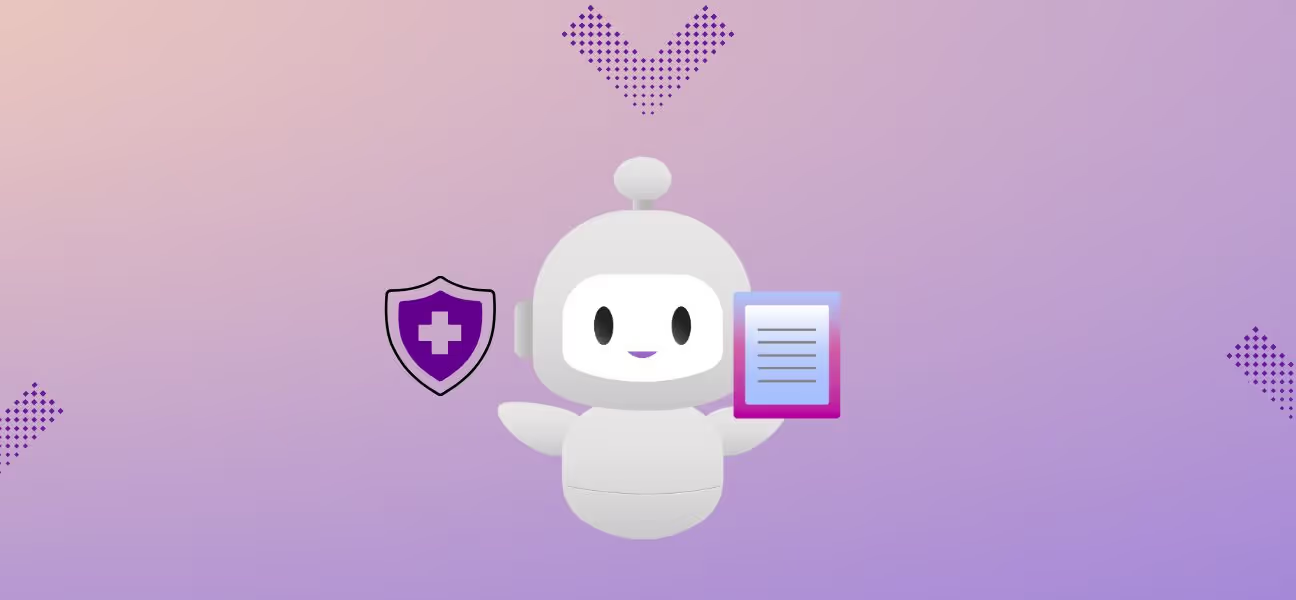
AI is an innovative technology for healthcare response teams. The promise is clear: automation can cut your response times, improve compliance, and free specialists to focus on clinical and strategic priorities instead of manual drafting.
But when you start integrating AI into your RFP workflows, barriers surface quickly. You may lack structured processes, face fragmented systems, or struggle with inconsistent data. In fact, 57 percent of organizations estimate their data is not AI-ready, which puts you at risk of delays, errors, and wasted investment. These challenges demonstrate that adoption involves more than simply selecting a tool.
Before you can fully realize the benefits, you need a plan to overcome these barriers. This blog gives you a step-by-step approach to prepare your systems, teams, and data for successful AI integration in healthcare RFPs.
What you’ll learn in this guide:
- A detailed checklist of pre-integration steps, including data readiness, system alignment, and stakeholder buy-in.
- A comprehensive guide to integration execution, covering workflow automation, pilot projects, and training.
- A framework for post-integration evaluation, ensuring performance monitoring and continuous improvement.
- Clear direction on pitfalls to avoid and best practices to adopt for long-term success with AI in healthcare RFPs.
Why Healthcare AI Implementation Matters
Healthcare organizations face immense pressure to deliver efficient patient care while maintaining strict compliance and controlling operational costs. Artificial intelligence is no longer optional; it has become a strategic lever that transforms workflows, strengthens decision-making, and accelerates revenue generation when implemented effectively.
What Kind of AI Powers Modern RFP Platforms?
Modern RFP platforms are no longer limited to simple automation rules. They use advanced AI technologies that understand context, learn from past responses, and continuously improve proposal quality.
- Large Language Models (LLMs): These models analyze vast amounts of proposal and industry data to generate coherent, context-aware draft responses, saving hours of manual writing.
- Contextual Response Engines: Go beyond keyword matching by understanding the intent behind questions and recommending the most relevant, tailored content.
- Adaptive Learning Systems: Improve over time by learning from edits, reviewer feedback, and win/loss outcomes to refine recommendations.
- Automation + Intelligence: AI integrates with existing workflows to handle repetitive tasks like content tagging, compliance checks, and formatting while enabling smarter decision-making.
This combination of automation and intelligence allows proposal teams to respond faster, with greater accuracy and consistency, while positioning their organization as a forward-looking partner in healthcare.
Benefits of AI-Driven Automation in Healthcare Proposals
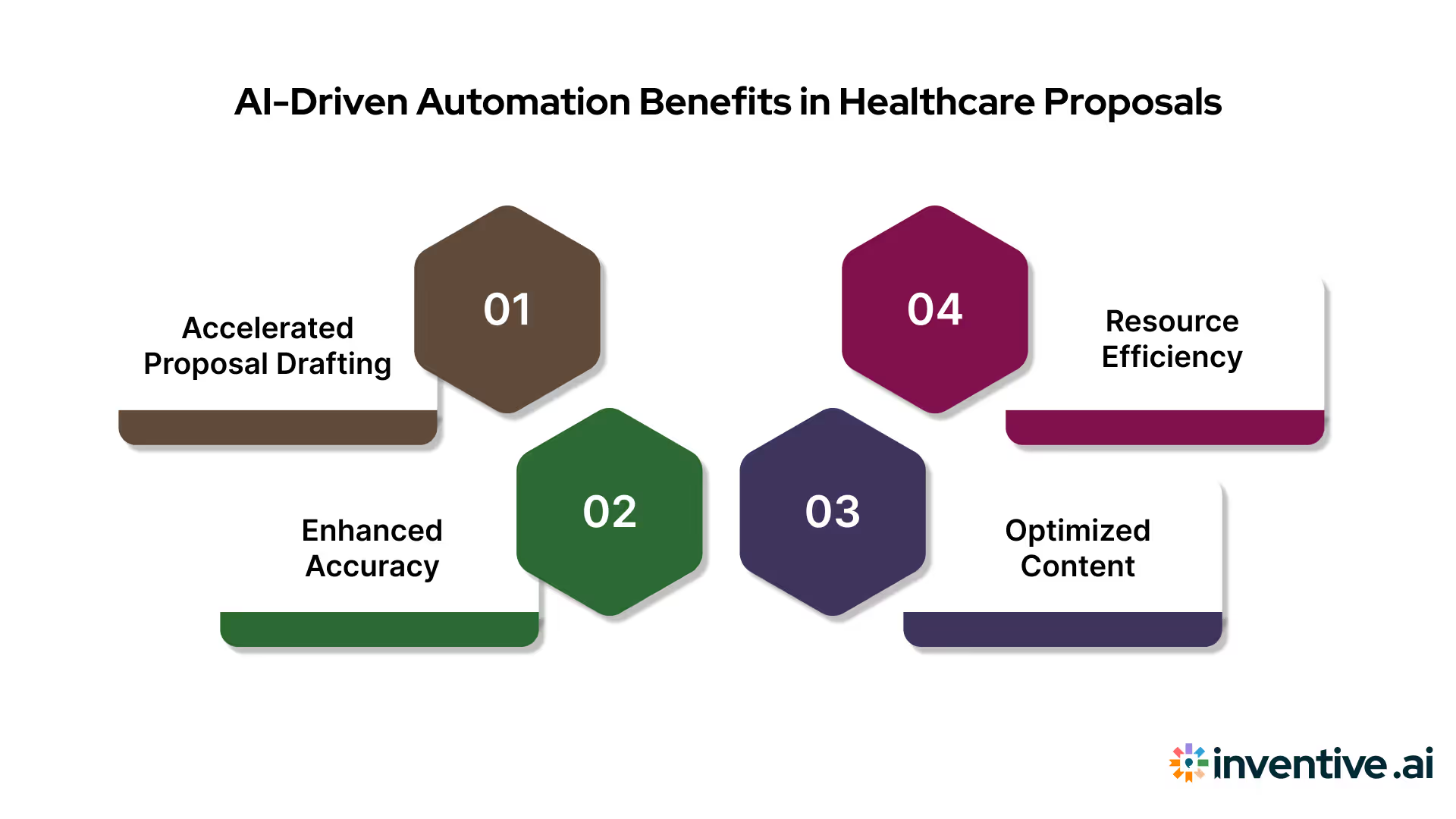
Implementing AI in the healthcare RFP process directly addresses the inefficiencies inherent in traditional RFP and RFI workflows. The impact is measurable and multifaceted:
1. Accelerated Proposal Drafting
- Automation platforms can produce highly accurate first drafts up to 10 times faster than manual methods.
- By integrating knowledge sources from previous proposals, internal databases, and legacy tools, repetitive research tasks are minimized.
2. Enhanced Accuracy and Compliance
- AI ensures responses adhere to regulatory requirements such as HIPAA, HITECH, and state-specific privacy mandates.
- Compliance matrices can flag gaps before submission, reducing the risk of costly errors or disqualifications.
3. Optimized Content for Higher Win Rates
- AI identifies content gaps and recommends responses based on winning patCurrent Challenges in Healthcare AI Adoptionterns in prior proposals.
- By highlighting missing information or inconsistent messaging, proposals align closely with evaluators’ expectations, increasing chances of success.
4. Resource Efficiency and Team Productivity
- Reduces the burden on proposal managers, allowing SMEs to focus on strategy instead of document assembly.
- Streamlined collaboration ensures all stakeholders are working on the latest version without versioning conflicts or delays.
Current Challenges in Healthcare AI Adoption
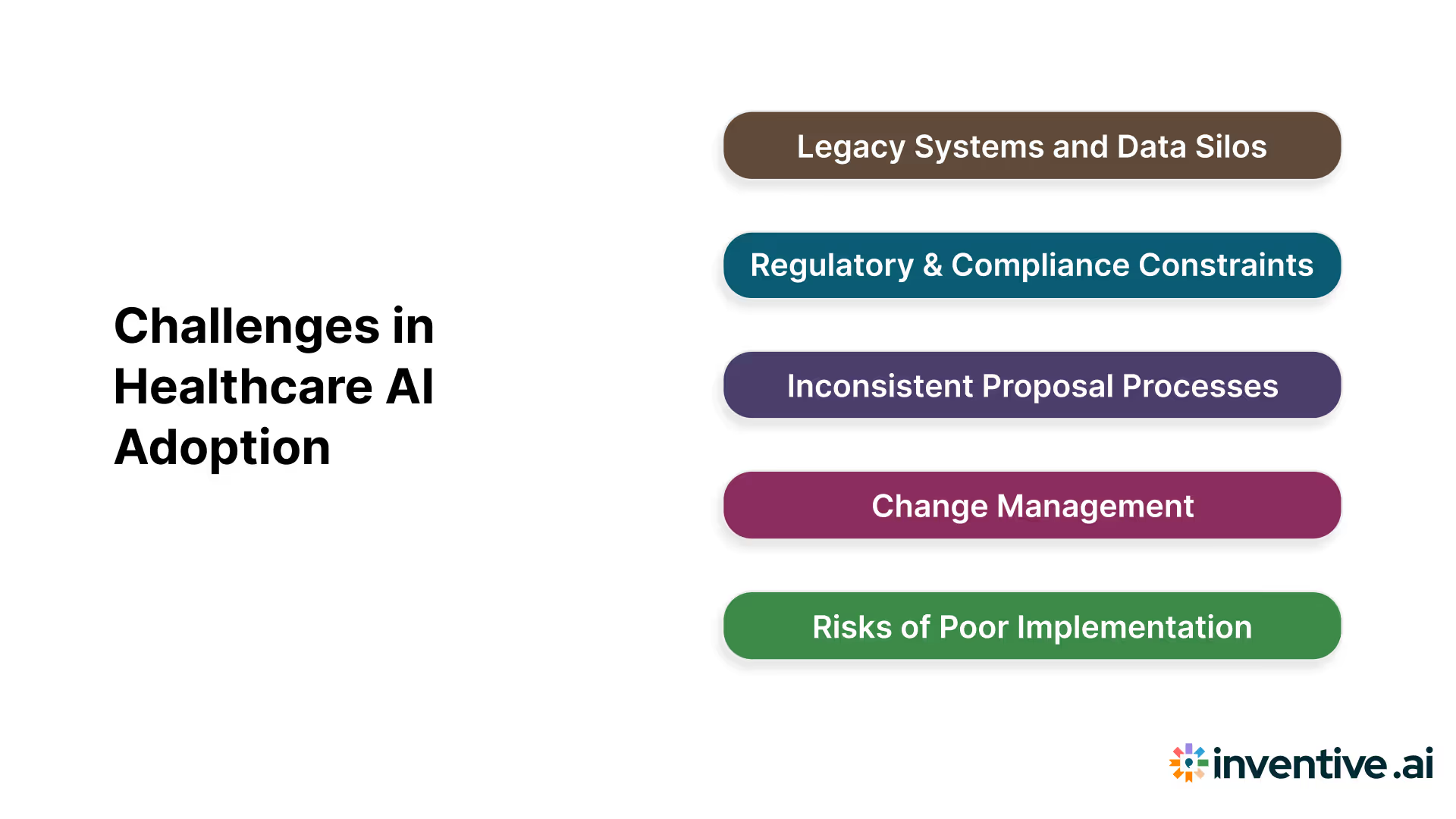
A recent American Medical Association (AMA) survey found that 41% of physicians felt both excited and concerned about AI’s role in healthcare. The excitement centers on its potential to improve care delivery and efficiency.
The concern lies in the risks of implementation. As AMA President Jesse M. Ehrenfeld, MD, MPH emphasized: “Above all else, healthcare AI must be designed, developed and deployed in a manner which is ethical, equitable, responsible and transparent.”
This dual sentiment captures the reality of healthcare AI today: the technology is promising, but its adoption faces significant barriers. Below are the key challenges organizations must address for successful integration.
1. Legacy Systems and Data Silos
Healthcare IT infrastructure often consists of fragmented systems that do not communicate effectively. Electronic medical records, departmental databases, and proposal management tools remain disconnected, limiting AI’s ability to provide holistic insights.
Key issues:
- Multiple unconnected data sources reduce the accuracy of AI outputs.
- Manual workarounds slow down proposal preparation.
- Lack of interoperability increases costs and delays.
Pro tip: Begin by consolidating proposal and compliance-related knowledge sources in a single hub before introducing advanced AI features.
2. Regulatory and Compliance Constraints
Healthcare is governed by strict standards such as HIPAA and HITECH. If AI-generated content fails to meet these requirements, it can expose organizations to penalties or disqualification from contracts.
Key issues:
- AI responses may overlook nuanced compliance rules.
- Manual validation of lengthy security questionnaires creates bottlenecks.
- Audit requirements add pressure on proposal managers.
3. Slow and Inconsistent Proposal Processes
Traditional RFP workflows involve multiple stakeholders, repeated handoffs, and time spent on formatting rather than strategy. Without automation, teams lose valuable time and consistency across submissions.
Key issues:
- Most of the proposal preparation time goes into manual research and assembly.
- Version conflicts arise when teams work on separate versions.
- Missed deadlines lower win rates.
Pro tip: Adopt AI-driven proposal platforms that produce accurate first drafts within minutes and streamline collaboration in a single environment.
4. Team Readiness and Change Management
Technology adoption fails when teams are not prepared to adapt their workflows. Proposal managers, SMEs, and sales teams may resist using AI if the benefits are unclear or if training is insufficient.
Key issues:
- Lack of clear workflows for AI use leads to underutilization.
- Teams fear AI will replace their expertise instead of augmenting it.
- Without leadership buy-in, adoption rates remain low.
Pro tip: Implement structured training sessions and frame AI as an assistant to human expertise, not a replacement.
5. Risks of Poor Implementation
Even advanced AI platforms deliver poor results if implementation is rushed or unstructured. Without proper data preparation and governance, outputs may be inconsistent or misleading.
Key issues:
- Inaccurate responses due to unclean or outdated data.
- Content duplication that reduces credibility.
- Misaligned messaging that weakens proposal impact.
Pro tip: Start with small-scale pilots, validate accuracy with clear metrics, and then expand deployment gradually.
Recognizing these barriers is only half the battle. The real question is how healthcare organizations can implement AI effectively, while sidestepping these risks. The next section lays out a step-by-step healthcare AI implementation checklist designed to guide teams through adoption with clarity and confidence.
Step-by-Step Healthcare AI Implementation Checklist
For healthcare suppliers, the ability to respond to healthcare RFPs quickly, accurately, and in compliance with regulatory standards can determine whether deals are won or lost. Implementing AI into the proposal process is not just about adopting a new tool — it’s about transforming how response teams work from preparation through submission and beyond.
The most effective way to approach AI adoption is to follow the same rhythm as the RFP response lifecycle. That means structuring implementation into three phases:
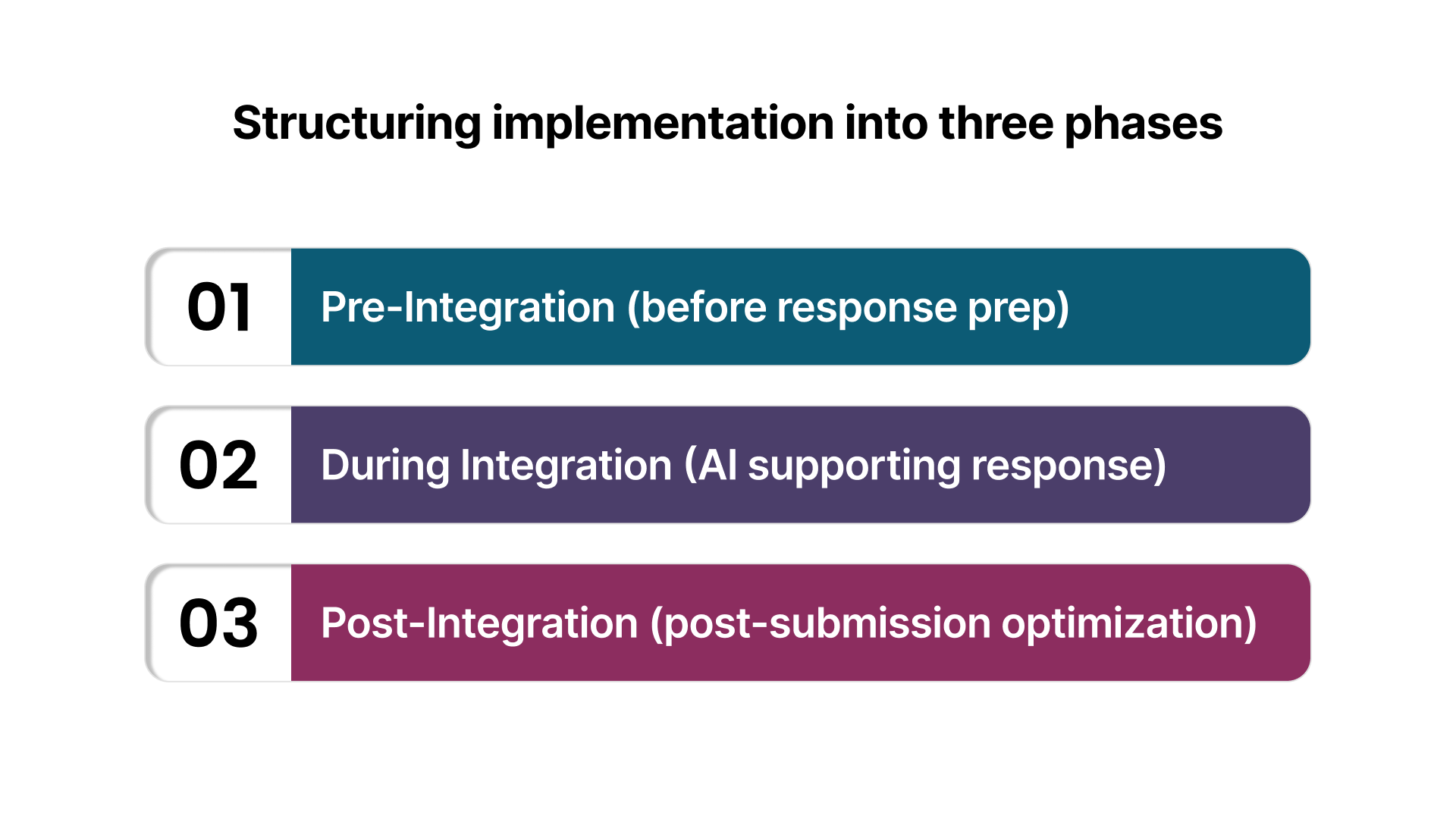
- Pre-Integration (before response preparation begins)
- During Integration (while AI is actively supporting response development)
- Post-Integration (after submissions, focusing on optimization and scaling).
By aligning AI implementation with the RFP process itself, healthcare suppliers can achieve measurable improvements in draft speed, proposal accuracy, compliance confidence, and ultimately win rates.
Phase 1: Pre-Integration: Building the Foundation Before AI Enters the Workflow
AI adoption fails most often when organizations skip the groundwork. For healthcare suppliers, rushing into implementation without preparation can expose compliance risks, introduce errors in clinical or regulatory data, and lead to missed deadlines. Pre-integration is about laying the right foundation so the technology enhances, rather than disrupts, the RFP automation in healthcare with AI.
Key Priorities in the Pre-Integration Stage:
1. Audit Your Current Proposal Workflow
- Map how proposals are developed today, from the intake of RFP requirements to final approval.
- Identify pain points: long response times, repetitive content creation, or compliance bottlenecks.
- Clarify which steps can benefit most from automation (e.g., content retrieval, formatting, compliance checks).
2. Align AI Goals With Business Outcomes
- Define measurable targets like reducing turnaround time by 40%, improving compliance accuracy to 95%, or increasing win rates.
- Prioritize outcomes that matter to both sales and compliance leaders, not just the proposal team.
3. Prepare the Content Library
- Centralize past proposals, compliance documentation, and medical product data sheets.
- Cleanse and update records so AI learns from approved, current information rather than outdated content.
- Establish tagging and metadata standards to ensure faster retrieval.
4. Address Compliance and Data Security Early
- Confirm that the AI solution meets HIPAA, GDPR, and other applicable healthcare regulations.
- Define access levels, like what information proposal writers can access versus reviewers or compliance officers.
- Document approval workflows to avoid unauthorized responses being generated.
5. Train Teams for Change Readiness
- Engage proposal managers, compliance officers, and sales teams early in the process.
- Provide clarity on how AI will support, not replace, their expertise.
- Offer scenario-based training on reviewing AI-generated responses for accuracy and compliance.
For a practical view of how this looks in action, see our guide on examples of AI workflow for healthcare RFPs, which breaks down real-world use cases.
This foundation ensures that once AI enters the proposal workflow, it doesn’t just accelerate output but does so with compliance and precision intact. The next phase focuses on how AI functions within the live RFP cycle itself, where speed and accuracy directly affect win probability.
Phase 2: During Integration: Embedding AI Into the RFP Cycle
Once the groundwork is in place, the focus shifts to execution. This stage is where AI directly supports the proposal team during live RFP cycles. For healthcare suppliers, the key is balancing speed with precision: proposals must be fast, but never at the expense of compliance or credibility.
Key Priorities in the During-Integration Stage
1. Automate the First Draft
- Deploy AI to draft baseline responses from the content library instantly.
- Reduce repetitive writing for standard questions, such as certifications, product specifications, or clinical validation data.
- Free up SMEs and compliance officers to focus on complex sections.
2. Apply AI for Compliance Checks
- Run automated scans for alignment with HIPAA, FDA, or payer requirements.
- Flag missing or outdated references that could otherwise result in rejection.
- Build in automatic audit trails to demonstrate compliance during reviews.
3. Enable Real-Time Collaboration
- Use AI-powered platforms that allow multiple stakeholders, like proposal managers, clinical experts, and legal reviewers, to collaborate in one workspace.
- Apply role-based controls to ensure edits align with compliance protocols.
4. Leverage Analytics for Decision-Making
- Track how long teams spend on each RFP section and use AI insights to refine workflows.
- Monitor win rates over time to measure ROI.
To see how this plays out step by step, refer to our dedicated Guide to RFP Automation in Healthcare with AI, which showcases typical automation paths from intake to final submission.
The efficiency gains realized here set the stage for long-term value, but sustaining that value depends on how organizations manage the post-integration period.
Phase 3: Post-Integration: Sustaining and Scaling AI Value
AI implementation doesn’t end at launch. Gartner survey finds 45% of organizations with high AI maturity keep AI projects operational for at least three years. To ensure the system continues to deliver value, healthcare suppliers need to focus on refinement, measurement, and scaling.
Key Priorities in the Post-Integration Stage:
1. Monitor Performance Against Business Outcomes
- Regularly measure whether AI has achieved the goals defined in the pre-integration stage.
- Track metrics such as turnaround time, compliance error rates, and win percentage.
2. Update the Content Library Continuously
- Feed new RFP responses, updated certifications, and revised product data back into the system.
- Remove outdated or non-compliant content to reduce AI drift.
3. Refine User Training and Adoption
- Collect feedback from proposal managers and SMEs on AI usability.
- Offer refresher training sessions to reinforce best practices.
4. Scale Across Additional Workflows
- Extend AI beyond RFP responses into related areas like contract management, partner proposals, or payer negotiations.
- Use insights from analytics to replicate success across departments.
5. Establish Governance and Oversight
- Set up ongoing review boards to evaluate compliance risks.
- Ensure ethical AI practices in line with industry standards and regulatory expectations.
Post-integration is when organizations can fully unlock the value of RFP automation in healthcare with AI. By continuously refining data quality, scaling automation, and embedding governance, suppliers not only respond faster but also strengthen compliance and credibility in every submission.
Best Practices for AI-Driven RFP Automation in Healthcare
Following a phased checklist helps healthcare suppliers adopt AI systematically, but long-term success depends on embedding a few overarching best practices into the process. These ensure the technology is not only implemented, but trusted, scalable, and value-generating.
Gain Insight From Resistance
Resistance isn’t just an obstacle. It’s a signal. When proposal teams or compliance officers raise concerns, they often highlight blind spots that early adopters miss.
- Engage skeptics early: Involve non-adopters during pilot projects to surface potential biases and risks.
- Use resistance as feedback: Capture objections and turn them into refinements in AI workflows.
- Example: A compliance manager reluctant to use automated drafting may reveal regulatory gaps that the implementation team must address.
Infrastructure and Optimization Requirements
Suppliers cannot rely on legacy systems to support AI. Successful adoption requires:
- Data readiness: Structured, high-quality proposal data linked to compliance repositories.
- Model training: Healthcare-specific terminology, certifications, and payer requirements must be embedded into AI training sets.
- Ongoing optimization: AI models need regular fine-tuning to stay aligned with shifting regulations and clinical standards.
Build an AI-Proficient Team
Technology succeeds only when people know how to apply it. In fact, Statista's study found that 50 percent of businesses cited a lack of skilled professionals as the biggest barrier to AI adoption.
- Train proposal writers to supervise AI outputs, not just consume them.
- Develop hybrid roles where proposal managers combine domain expertise with AI fluency.
- Use real RFP cycles as live training opportunities.
Prioritize Human Skills
AI adoption is most effective when paired with uniquely human strengths. Creativity, adaptability, and critical thinking allow teams to shape automation into a competitive advantage.
- Rotate team members into AI pilot projects to encourage adaptability.
- Pair clinical SMEs with AI tools to capture nuanced healthcare insights.
- Encourage problem-solving exercises where humans and AI collaborate, not compete.
Measure What Matters
Integration succeeds only when outcomes are visible.
- Define KPIs like drafting speed, compliance error reduction, and RFP win rate.
- Appoint “AI champions” who adapt workflows to team needs and provide real-time support.
- Ensure adoption is measured not just by usage, but by tangible improvements in proposal success.
Together, these practices turn potential resistance into adoption fuel and ensure that RFP automation in healthcare with AI doesn’t stop at installation, but translates into measurable impact.
Common Pitfalls and How to Avoid Them
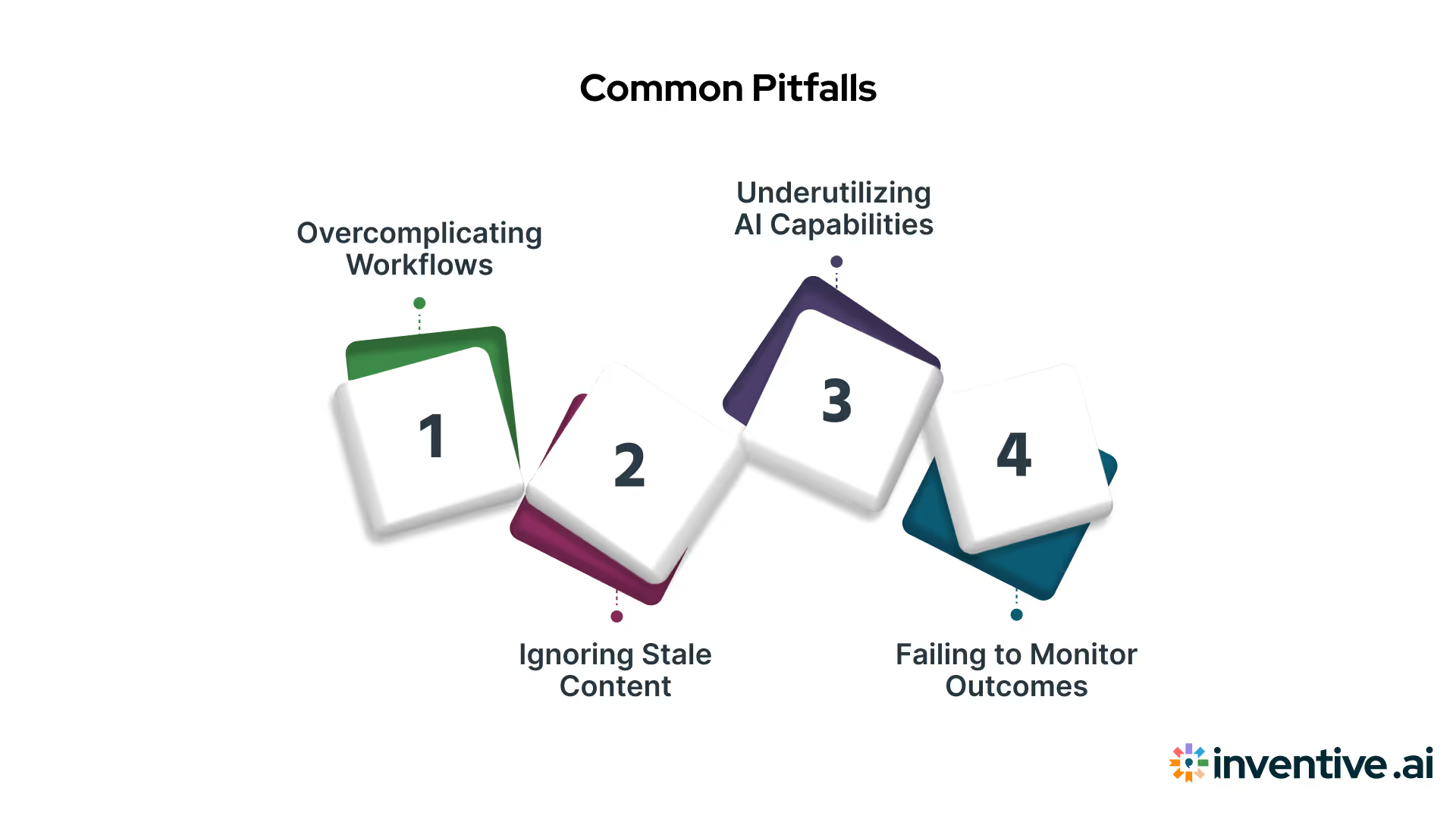
Even the most sophisticated healthcare suppliers can run into problems when integrating AI into their RFP workflows. These pitfalls don’t just delay adoption—they erode trust in automation and reduce the ROI decision-makers expect. Below are the most frequent mistakes, why they matter, and how to prevent them using Inventive AI.
1. Overcomplicating Workflows
Teams attempt to replicate every detail of their manual process inside the AI platform. This creates unnecessary steps, clutters the workflow, and slows response times. CFOs and VPs of Sales care about time-to-submission. Over-engineered workflows make automation feel heavier than the manual process it was meant to replace.
How to avoid it:
- Map only the essential steps of your RFP process into AI.
- Standardize templates and response formats instead of creating custom rules for each RFP.
Pro Tip: Start with a lean automation path. Once adoption is strong, add refinements only where they add measurable efficiency.
2. Ignoring Stale Content
Outdated product, compliance, or pricing information gets reused because teams assume the AI library is always current. In healthcare RFPs, one incorrect regulatory reference or expired certification can cost suppliers the deal. Accuracy is not optional.
How to avoid it:
- Establish quarterly audits of your RFP content library.
- Tag time-sensitive materials (licenses, certifications, clinical data) with auto-expiry in Inventive AI.
- Leverage the 0% hallucination rate by feeding the system with verified, structured content.
3. Underutilizing AI Capabilities
Teams limit AI to drafting boilerplate responses and ignore advanced features like automated compliance checks, win-rate analytics, and real-time collaboration.
How to avoid it:
- Train RFP managers to use Inventive AI’s advanced analytics dashboards.
- Apply response scoring to predict win probability before submission.
- Automate compliance validation across HIPAA, FDA, and other healthcare regulations.
4. Failing to Monitor Outcomes
Once AI is live, teams rarely track whether automation is improving speed, accuracy, or win rates. This blinds CFOs to the ROI of their investment.
Without metrics, leadership cannot prove cost savings or revenue gains, making it harder to secure future technology budgets.
How to avoid it:
- Define KPIs upfront: response time reduction, accuracy levels, and win rate improvement.
- Review reports monthly to track adoption and business impact.
What to Look for in a Healthcare AI Proposal Platform
Choosing the right platform is about more than features; it’s about ensuring security, usability, and long-term success. When evaluating vendors, focus on these essentials:
- HIPAA & GDPR Compliance: Verify that the platform adheres to healthcare privacy and data protection regulations. Built-in safeguards like encryption, audit trails, and access controls are critical for handling sensitive patient or financial data.
- Integration Capabilities: Look for seamless connections with your CRM, document repositories (e.g., SharePoint), communication tools, and e-signature platforms. Strong integrations reduce manual effort and ensure proposals stay aligned with live business data.
- Content Management Features: A centralized knowledge base, duplicate detection, auto-expiry tagging, and metadata management ensure your proposal library stays accurate, compliant, and easy to search.
- User Training & Support: The best platforms don’t just provide software — they empower teams. Comprehensive onboarding, role-specific training, and responsive support are essential for driving adoption and maximizing ROI.
Evaluating platforms against these criteria helps healthcare organizations adopt AI responsibly while ensuring every proposal is accurate, secure, and positioned to win.
How Inventive AI Elevates Healthcare RFP Integrations
Inventive AI is designed to slot seamlessly into your existing healthcare RFP workflows. Instead of simply speeding up response drafting, it brings structure, intelligence, and adaptability across the full integration journey. Here’s how it plays out:
- AI RFP Agent: Generates complete responses in minutes using past wins and approved content, cutting manual drafting and freeing SMEs to focus on clinical accuracy.
- Contextual Response Engine: Adapts tone, terminology, and priorities to mirror each buyer, leading to more credible answers and higher evaluation scores.
- Smart Knowledge Hub: Consolidates compliance, clinical, and policy documents into one searchable source, reducing version errors and ensuring teams always respond with audit-ready content.
- Competitor & Buyer Research Agents: Surface intelligence on rival pricing, positioning, and buyer expectations, helping teams avoid price-only competition and secure a strategic edge.
- Collaborative Workspace: Enables procurement, IT, and compliance teams to review in real time, eliminating bottlenecks and consistently delivering on-time submissions.
- AI Content Management: Detects and flags outdated or conflicting material before it reaches reviewers, improving accuracy rates to 95% or higher.
With AI-powered RFP response software, Inventive AI automates the complex RFP management workflow, saving time and improving proposal accuracy. Ready to see how Inventive AI RFP Automation enhances your sales process? Book a Demo Today
Conclusion
Healthcare RFPs are complex, time-sensitive, and often overloaded with compliance requirements that drain supplier teams. Throughout this guide, we explored how structured workflows, best practices, and AI-driven automation simplify the process. From reducing manual effort to improving accuracy and alignment with buyer needs, modern RFP response management is no longer just about speed but about building credibility and securing measurable results.
Inventive AI transforms this process for healthcare suppliers and procurement teams by delivering an AI-powered RFP response platform that removes inefficiencies and strengthens outcomes. CFOs, sales leaders, and bid managers can accelerate proposal cycles, ensure every submission is accurate and compliant, and increase win rates with technology that works directly inside their existing systems.
Ready to streamline your RFP response process and see measurable improvements in performance? Request a demo and discover how AI integration in healthcare proposals drives efficiency, compliance, and better win rates with Inventive AI.
FAQs on AI Integration in Healthcare Proposals
1. Why is AI being used in healthcare proposals?
AI helps organizations manage the complexity of healthcare procurement by automating drafting, ensuring compliance with strict regulations, and improving accuracy in proposal content.
2. What types of tasks can AI automate in healthcare RFPs?
AI can automate repetitive tasks such as generating first drafts, organizing compliance documents, managing version control, and analyzing historical proposal data to create stronger responses.
3. How does AI support compliance in healthcare proposals?
Healthcare proposals must meet strict standards. AI systems can flag outdated or non-compliant information, ensure alignment with current policies, and reduce the risk of errors that could disqualify a submission.
4. Can AI adapt proposals for different healthcare buyers?
Yes. AI tools analyze buyer documents, policies, and priorities to customize responses so proposals reflect the buyer’s specific requirements rather than generic answers.
5. What is the biggest benefit of integrating AI into healthcare proposals?
The greatest advantage is speed with accuracy. Teams can respond faster without sacrificing compliance or quality, which increases the likelihood of winning competitive healthcare contracts.
6. How do you calculate the ROI for an AI proposal tool?
ROI is typically measured by combining time savings, resource efficiency, and revenue impact. A simple formula is:
ROI (%)=Total Benefits – Total CostsTotal Costs×100\text{ROI (\%)} = \frac{\text{Total Benefits – Total Costs}}{\text{Total Costs}} \times 100ROI (%)=Total CostsTotal Benefits – Total Costs×100
- Total Benefits = (Hours saved × Average hourly rate) + (Additional revenue from improved win rates) + (Reduced external costs)
- Total Costs = Subscription + implementation + training
For example, if automation saves 1,000 hours per year, improves win rates to add $500K in revenue, and reduces $50K in outsourcing — against $120K in costs — the ROI exceeds 400%.
7. Is my healthcare data secure with an AI platform?
Yes, leading platforms are built to protect sensitive healthcare and patient-related data. Look for features such as HIPAA and GDPR compliance, data encryption, role-based access controls, and audit logging. Many vendors also maintain certifications like SOC 2 or ISO 27001.


